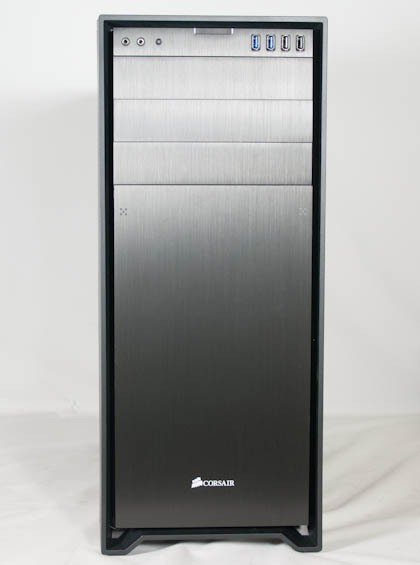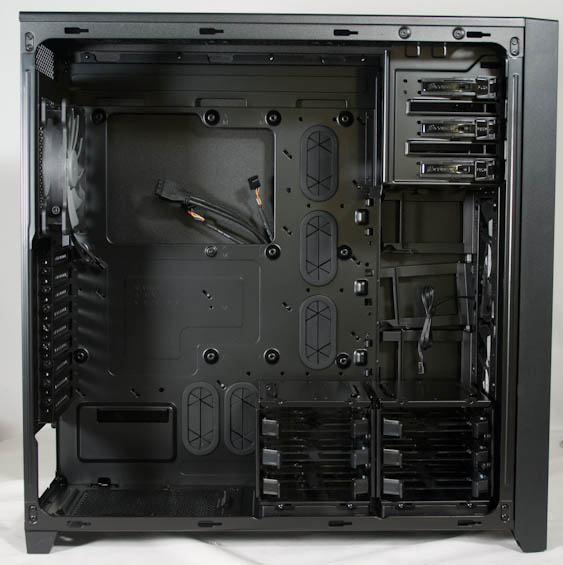Corsair Obsidian 750D Case Review
by Dustin Sklavos on September 24, 2013 6:00 AM EST- Posted in
- Cases/Cooling/PSUs
- Corsair
- ATX
- Case
_678x452.jpg)
Corsair's case lineup has been growing over time with a trickle down approach, as they launched with the venerable (and expensive) Obsidian 800D and have been able to shrink all the way down to the Carbide 200R. Yet outside of the Obsidian 900D, their enthusiast high end (as opposed to the obscene beast that is the 900D) has actually remained relatively unchanged. Today the Obsidian 750D launches, covering the space the 700D and 800D used to occupy while trickling down the 900D's industrial design.

The "lip" that was on the Graphite 600T has become a part of the ID for Corsair's new Obsidian cases, and I like it. Corsair has actually turned it into a fairly smart, useful design cue; there are no unsightly vents on the front fascia of the Obsidian 750D, but the large plate at the bottom is actually almost totally ventilated in the surrounding area. It's a slick design. The black aluminum fascia suits the 750D and allows it to stand out even amongst other "black monolith" style enclosures. Corsair has also taken to using large square windows on the sides of their cases, and these sharp angles suit the rest of the ID well. Whoever is handling ID over there should be proud.

The interior of the 750D is a pretty bog standard case design, but it sports all the usability I've come to expect from Corsair. Both 3.5" drive cages are removable (or stackable), and toolless 2.5" drive cages line the back off the case (one of mine was jostled slightly in shipment). Corsair has been experimenting both with doing away with 3.5" drives (the Carbide Air 540 only supports two) and toolless 2.5" drive mounting methods, but the fly in the ointment for the latter has been the increasing popularity of 7mm drives instead of 9.5mm ones.
Air cooling is handled by a pair of 140mm intake fans and a 140mm exhaust fan; there's space to mount additional fans (or radiators) in the top of the 750D as well, and a large magnetic "sheet filter" is in place on the top of the case. Interestingly, Corsair has forgone including a fan controller with the 750D; instead, the 140mm fans are just tuned to what will hopefully be a happy medium.
| Corsair Obsidian 750D Specifications | ||
| Motherboard Form Factor | Mini-ITX, Micro-ATX, ATX, EATX, XL-ATX | |
| Drive Bays | External | 3x 5.25" |
| Internal | 6x 2.5"/3.5", 4x 2.5" | |
| Cooling | Front | 2x 140mm intake fan (supports 2x 120mm) |
| Rear | 1x 140mm exhaust fan (supports 120mm) | |
| Top | 3x 120mm/2x 140mm fan mount | |
| Side | - | |
| Bottom | 2x 120mm fan mount (with 3.5" cages removed) | |
| Expansion Slots | 9 | |
| I/O Port | 2x USB 3.0, 2x USB 2.0, 1x Headphone, 1x Mic | |
| Power Supply Size | ATX | |
| Clearances | HSF | 180mm |
| PSU | 200mm with drive cages | |
| GPU | 340mm with drive cage / 460mm without | |
| Dimensions | 21.5" x 9.3" x 22.1" 546mm x 235mm x 560mm |
|
| Special Features | Removable drive cages Toolless 2.5" caddies |
|
| Price | $159 | |
The Obsidian 750D is essentially hitting the mainstream of the high end. This is a fairly competitive market, and it behooves Corsair to have a strong entry at the $159 price point. What's interesting is that while one of Corsair's main competitors, NZXT, is cramming their cases full of useful features, Corsair seems to be stripping them down to the essentials. The interior is primarily modular, sure, but there's no fan control, no acoustic padding, no funky LED lighting, nothing like that; this is a streamlined enclosure that seems to be heavily geared toward liquid cooling. That's fairly typical of modern Corsair designs; the 900D's entire reason for being is really to be a liquid cooled system, and the cumulative 1020mm of radiator support in the 750D should be fairly telling.


_thumb.jpg)
_thumb.jpg)
_thumb.jpg)
_thumb.jpg)
_thumb.jpg)
_thumb.jpg)








40 Comments
View All Comments
alincioaba - Tuesday, September 24, 2013 - link
The 3.5" cages are stackable that's good... my question is can you add an extra one (provided that corsair will sell you one)?garadante - Tuesday, September 24, 2013 - link
Sure looks like it, as that's what they offered with the 900D. Perhaps the drive cages are even identical? I know the 900D came with 2 or 3 drive caves but you could have 5 installed total I think.Grok42 - Tuesday, September 24, 2013 - link
Not my choice of case for other reasons but I have to give them a lot of credit for being able to stack cages and selling additional ones. Now if they would only sell 2.5" in addition to 3.5" cages.BillyTheBigBone - Friday, February 14, 2014 - link
yes you can. I ordered one from them.Alan G - Tuesday, September 24, 2013 - link
In this day and age, two USB 2.0 along with two USB 3.0 ports on the front panel? Why?DanNeely - Tuesday, September 24, 2013 - link
At $159 "it's cheaper" isn't a good excuse; but I'm sure that's still part of it. Probably Corsair's explanation if asked would be that a lot of mid range mobos still only have a single USB3 header and very few people would be plugging in 3 USB3 devices at once anyway.IMO the better option would be to include either a short adapter cable to connect a USB3 cable to a USB2 header, or to wire the second connector onto the cable itself like the dual connector cable you often see on front panel audio. I'd prefer the first option because it lets people with 2 USB3 headers toss the adapter in their junkbox and have a cleaner build.
Liquid_Static - Tuesday, September 24, 2013 - link
What else is going to go there...LB-ID - Tuesday, September 24, 2013 - link
I was doing a fresh Win7 install on a new computer the other day, couldn't figure out why the keyboard and mouse kept going dead during the install process. Figured out it was lack of USB3 support on the OS, so was very very happy to have a couple of USB2 ports on my Nanoxia DS1. Sometimes it pays to have backwards compatibility available...Threnx - Tuesday, September 24, 2013 - link
I would like it a lot more without the gaudy window. It's 2013, who still thinks those look good? They should go the way of lighted LED fans.flemeister - Tuesday, September 24, 2013 - link
Not you, evidently! =DI love the look of a clean side panel window, free of any ugly fan grills. And anyway, it's 2013, where an all-black interior is now pretty much standard for ATX cases. More and more PSU's come with decent looking cables, whether just black insulation on the wiring, or braided sleeving installed by default. And it's *very* easy to find nice looking motherboards and video cards now, compared to ~2009 and earlier. There's been no better (or easier) time to show off the guts of your rig! =)